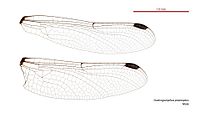Austroepigomphus praeruptus
Appearance
| Austroepigomphus praeruptus | |
|---|---|
| Scientific classification | |
| Domain: | Eukaryota |
| Kingdom: | Animalia |
| Phylum: | Arthropoda |
| Class: | Insecta |
| Order: | Odonata |
| Infraorder: | Anisoptera |
| Family: | Gomphidae |
| Genus: | Austrogomphus |
| Subgenus: | Austroepigomphus |
| Species: | A. praeruptus
|
| Binomial name | |
| Austrogomphus praeruptus | |

| |
| Synonyms[3] | |
|
Austrogomphus melaleucae Tillyard, 1909 | |
Austrogomphus praeruptus, also known as Austrogomphus (Austroepigomphus) praeruptus, is a species of dragonfly in the family Gomphidae,[4][5] It inhabits slow streams, rivers and ponds in eastern Australia.[3][6]
Austrogomphus praeruptus is a medium-sized, black and yellow dragonfly.[5]
Gallery
-
Female wings
-
Male wings
Note
The taxonomic status of Austrogomphus praeruptus and Austrogomphus melaleucae is uncertain. The type specimen originally used to describe Austrogomphus praeruptus is now lost.[5] It is probable that all dragonflies identified as Austrogomphus praeruptus may be Austrogomphus melaleucae if found north of the Victorian border.
See also
References
Wikimedia Commons has media related to Austroepigomphus praeruptus.
- ^ Dow, R.A. (2017). "Austroepigomphus praeruptus". IUCN Red List of Threatened Species. 2017: e.T14276321A59256663. doi:10.2305/IUCN.UK.2017-1.RLTS.T14276321A59256663.en.
- ^ Selys-Longchamps, E.; Hagen, H.A. (1857). "Monographie des Gomphines". Mémoires de la Société des Sciences de Liège (in French). 11: 257–720 [655] – via Biodiversity Heritage Library.
- ^ a b Theischinger, Gunther; Endersby, Ian (2009). Identification Guide to the Australian Odonata. Department of Environment, Climate Change and Water NSW. p. 201. ISBN 978 1 74232 475 3.
- ^ "Species Austrogomphus (Austroepigomphus) praeruptus (Selys, 1857)". Australian Faunal Directory. Australian Biological Resources Study. 2012. Retrieved 17 February 2017.
- ^ a b c Theischinger, Günther; Hawking, John (2006). The Complete Field Guide to Dragonflies of Australia. Collingwood, Victoria, Australia: CSIRO Publishing. p. 178. ISBN 978 0 64309 073 6.
- ^ Watson, J.A.L.; Theischinger, G.; Abbey, H.M. (1991). The Australian Dragonflies: A Guide to the Identification, Distributions and Habitats of Australian Odonata. Melbourne: CSIRO. p. 278. ISBN 0643051368.



